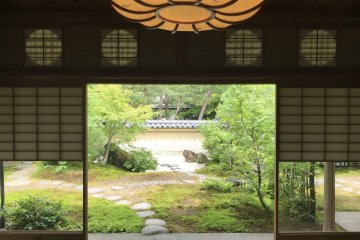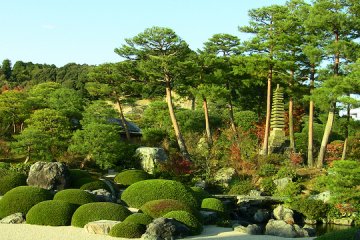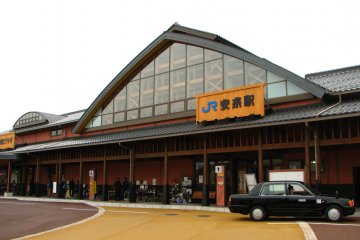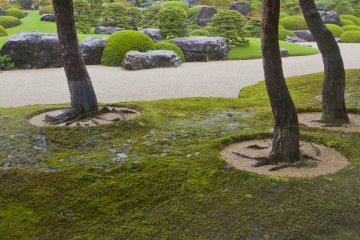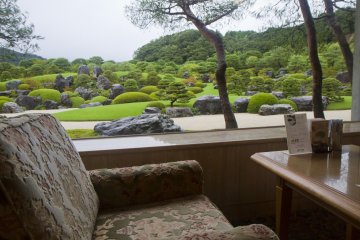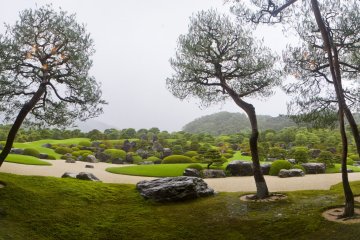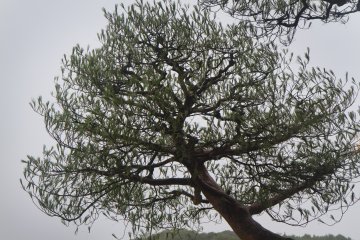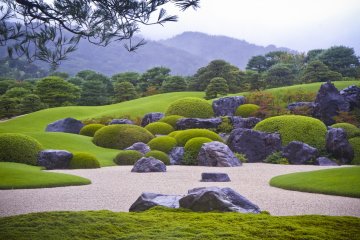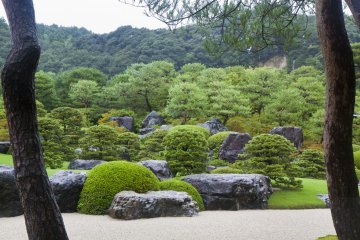Midori, one of the four cafés at the Adachi Museum of Art, is elegant and modern with views looking out at the Dry Landscape Garden as well as the White Gravel and Pine Garden through a glass wall. Soft classical music flows through the air and wait staff stand ready, diligently at your service.
The coffee and cakes, though higher in price than your average café, are good. But 1000 yen for coffee is worth it here, as the clientele are drawn to what is regarded by the Journal of Japanese Gardens as the number one garden in the world. After spending a couple of hours viewing all of the museum’s gardens, as well as the paintings and ceramics on exhibit, this café was my choice for relaxing a bit while getting one more good, long moment to soak in the energy of the garden and allow my mind to ponder both the creation of the garden and the garden itself.
One of the interesting aspects of the museum is that all staff participate in maintenance of the garden every day. Yes, everyone—including the folks making your coffee as well as the one bringing it to your table—spends nearly an hour each morning in the garden maintaining and cleaning this special environment. This diversion from the trend of increased specialization in work allows for all museum employees to be fully invested in the garden and to come to know and appreciate its intricacies deeply. It’s part of the coordinated effort of constant improvement laid out by the museum’s founder to bring your experience here to a level that is unmatched by any other Japanese garden.
Just looking at this landscape painting come alive is sure to move you. But a few details about the view through the café glass of the Dry Landscape Garden follow here that may be of further interest.
It was raining on this day in August, and the large standing stones, imported from Okayama, revealed a normally hidden part of their appeal. Emblematic of mountains, they anchor the view and furthermore have the capacity to hold water, giving off a delightful black sheen when wet. The weather won’t dampen your visit here, however, as you’ll be comfortably indoors, and the scenery, though more mellow than on a day of sunshine, still puts on a beautiful display of part of its diverse character that alters with weather and season.
Red pines, or akamatsu, occupy the small mossy hill just past the glass. Observe the tall, smoother, redder trunks of these pines in contrast to the others out in the lawn. The circle surrounding the trunks of the trees allows for their roots to be highlighted. Also related to the rain are the black spots on the ground just outside the window. These are charcoal blocks there to prevent water damage caused by rain dripping from the branches above.
The gravel, brought in from Yokota in Shimane, flows like water around the turf and throughout the garden. Mt. Katsu and Mt. Kikaku are the highest of the low mountains that enclose the view, and a manmade waterfall can be seen from the café up high to the far right of this garden.
The low, rounded bushes are macranthum azaleas, known as satsuki in Japanese, which bloom in late May and early June. The small reddish shrubs are another azalea, dodan-tsutsuji, which produces tiny white flowers shaped like bags or balloons in May and has foliage that turns bright orange and red in fall. Animals inhabit the garden, too, with Japanese wagtails, playful white and black birds that hop and flutter through the green grass and across the gravel, visiting the museum daily.
The other cafés include the traditional tea houses Juraku-an and Juryu-an, and Taikan, which has meals and views of the Pond Garden.
足立美術館—Adachi Bijutsukan—Adachi Museum of Art 喫茶室 翆—Kissashitsu Midori—Midori




